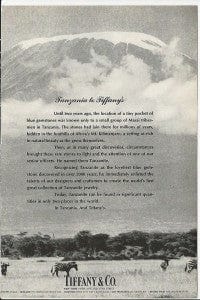The remote and barren region of Tanzania in East Africa might not seem like much at first. However, there rests a spirit in this place, possibly familiar to those who have read Ernest Hemingway’s The Snows of Kilimanjaro, that holds one of the world’s best-kept secrets: a buried treasure of sorts, a gemstone jackpot. In the deep, dry foothills of this mystifying region under the towering and stunning snow cap of Mt. Kilimanjaro, there exists the only known mining region for one of the most beautiful gemstones: Tanzanite.

The discovery of beautiful Tanzanite gemstones is a relatively new one. In 1967, nearly 50 years ago, a Maasai tribesman accidentally happened upon a cluster of highly transparent, intense blue crystals weathering out of the earth while herding his cattle. Initially believing he’d stumbled upon a large deposit of blue sapphire treasures, he frantically filled his pockets with the heavy weight of the luminous jewels. Instinctively thinking that these stones would bring his fellow tribesman eternal luck, the tribesman was unaware of the significant importance of what he had unearthed.

Untreated Tanzanite stones, like this 22-carat ring, are a rarity and are the epitome of style and glamour
Upon further gemological inspection by local stonecutter Manuel de Souza, it was concluded that an entirely new species of gemstone had been found. Indeed, no one had ever laid eyes on this mineral before. The gemstone market, consequently, was poised for its greatest discovery in 2000 years.
Not long after, the relatively covert and unseen Tanzanite gemstone arrived, by way of gemologist Campbell Bridges, into the prestigious office of renowned New York Jeweler, Tiffany & Co. When Bridges unveiled the striking violet-blue brilliance of this unknown stone to Tiffany’s wide-eyed vice president Henry B. Platt, the infatuation was instantaneous. Working hand in hand, Platt and Bridges were instrumental in the promotion and elevation of the new gemstone, positioning Tiffany as the first jeweler to bring this dazzling stone onto the world stage. In fact, it was Platt who named the blue gemstone! In 1968, recognizing its potential, Platt christened this new gemstone “Tanzanite,” after its country of origin.

Consequently, this stone took the world by storm. Advertisements by Tiffany proliferated, cleverly and proudly touting that the new blue gemstone could only be found in two places, “in Tanzania and at Tiffany’s,” lamenting it as “the most beautiful blue stone to be discovered in nearly 2000 years.” To no surprise, Tanzanite became one of Tiffany’s best sellers.
The rarity of Tanzanite jewelry is perhaps often too undervalued. Unlike other gems, beautiful Tanzanite gemstones have but one source: the mines at the foothills of Tanzania. There is nowhere else in this world other than this compact “band-aid” strip of land, 4 kilometers wide and 2 kilometers long to be exact, that a Tanzanite stone can be mined. In fact, experts agree that the chances of Tanzanite being found anywhere else in the world are less than one in a million, making this gemstone a thousand times rarer than diamonds. At the current rate of mine, it is estimated that the mines will be depleted within the next 25 years.
Undeniably, the discovery of the Tanzanite gem was a turning point in the gemstone market. In recognition of its popularity, the Tanzanite gem was declared the world’s most popular colored gemstone in both 1998 and 1999 and was named one of December’s birthstones in 2002. Celebrating births and new beginnings, the demand for this gemstone has continued to grow. In recent years, its exceptional gemstone color and rarity have become harder and harder to resist. It’s managed to capture the imagination of jewelry designers and collectors who have fallen in love with its mesmerizing color, fascinating origin, and captivating brilliance.
If you’re looking for beautiful antique jewelry, browse our collection at M.S. Rau to discover different types of earrings, necklace styles, and more.



